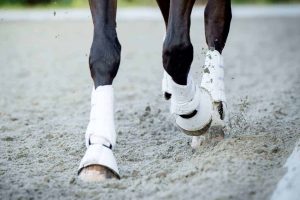For Facing Fear, Any (Horse) Friend Might Do

The simple presence of a second horse can either reduce the first horse’s reaction to frightening situations or help him calm down after the initial fright, said Claire Ricci-Bonot, PhD, of the Animal Behaviour, Cognition, and Welfare Group in the School of Life Sciences at the University of Lincoln, in the U.K.
“During its life, the horse is often confronted with new situations that can be stressful, such as transport, change of location, a dog jumping and barking near the horse, etc.,” Ricci-Bonot said. “One of the most important things to remember from our research would be the importance of having another horse present during (such) stressful situations.”
Testing Fear Reactions With and Without a Companion
In their recent study, the researchers paired 32 riding school horses with either a familiar or unfamiliar companion horse. (Familiar horses had been living together in group housing or a nearby stall, while the unfamiliar horses lived in different stables.) Then they taught half the companion horses to become accustomed to two suddenly appearing objects used in standard equine fear tests: an opening umbrella and a large, patterned ball placed on the ground near their feet.
After, the researchers measured each test horse’s heart rate and behavioral reaction to the opening umbrella and the black-and-white striped gymnastics ball, either when the horse was alone or paired with a companion—which was either familiar or unfamiliar and may or may not have been habituated to the scary objects. (They ran the tests in random orders to ensure the results didn’t show a learning effect.)
The scientists found the horses reacted more calmly to the ball when they had a companion, compared to when they were alone—regardless of how well they knew the companion, Ricci-Bonot said.
As for the opening umbrella, their fearful reactions were just as strong when they were with a companion as without, she said. However, when the companion was present, the horses’ heart rates dropped back to normal much faster than when they were alone, suggesting the companion had a post-reaction calming effect.
They didn’t see the same calming effect on heart rate during the ball test, said Ricci-Bonot. But that might have been because the heart rates were already lower as the horses reacted less fearfully to the ball in the company of the other horse, she said.
Is the Companion Habituated? It Might Not Matter …
Interestingly, said Ricci-Bonot, it didn’t matter whether the companion horse was accustomed to the scary stimulus—at least in this study. A Danish study carried out a few years ago found the opposite; the researchers there noted when companion horses were habituated to an opening umbrella, the test horses had less intense reactions to it. But in the new British study, the test horses’ responses to an opening umbrella or a ball set on the ground was the same regardless of whether the companion reacted fearfully.
That could be because the horses in the previous Danish study were 2-year-olds, and the horses in the new study were adult riding school horses averaging 13 to 14 years old, Ricci-Bonot said. The younger horses might have more readily modeled their behavior after their companion’s.
The study methods might have played a role, as well. Before running the scary object test, the researchers selected which horse in each pair would be the test horse and which would be the companion horse. They based their decisions on how quickly each horse got used to the testing arena (without scary objects). The researchers reasoned that horses that adapted to the new environment faster “would be more confident and, therefore, potentially a better social buffer,” the team stated in their paper, which appeared recently in Scientific Reports.
Even so, the mere presence of a second horse seems to be helpful, said Ricci-Bonot. “I think that just having the presence of a companion can help a horse face a stressful situation, even if a (habituated) demonstrator could be more effective,” she said.

Related Articles
Stay on top of the most recent Horse Health news with

















